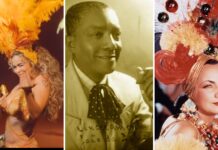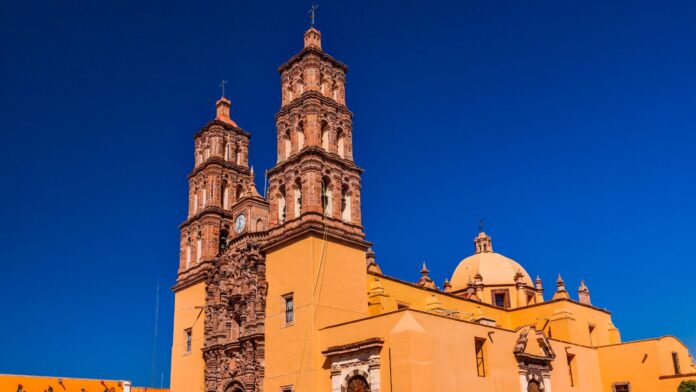There must be a natural spike in Party City’s stock value every May when Americans line up at the register to purchase candy-colored plastic margarita glasses and sombrero-shaped chip-and-dip platters for their annual cinco de mayo fest. Widely and mistakenly believed to be the day of Mexican independence from Spain, the fifth of May is instead a celebration of what was an already autonomous México’s defeat of Napoleon III’s army at the battle of Puebla in 1862. Cinco de mayo began as a debt-collecting mission by the European superpower, but quickly went awry.
As of 1863, southern Californians began holding their own commemorations of the victory at Puebla, a sign of solidarity with México, and since then Cinco de Mayo is an opportunity to share some aspects of the rich culture of México and renew bonds of friendship with our neighbors to the south. It’s also a great time of year to throw a backyard party, play rancheras and drink a beer or a soda made with real cane sugar, celebrating México’s victory at Puebla and of spring over winter.
El grito de Dolores or “the cry of Dolores”, celebrated on September 16th every year, is the prelude, one portion the official celebration of independence in México. While the original grito was an impassioned speech, delivered by a compelling figure at a dramatic hour, which triggered New Spain’s (now México) war for independence, today it’s a literal cry. Festivities akin to the 4th of July begin with un grito: three loud repetitions from prominent speakers and the crowd: ¡Que viva México!
This cry is followed by a dignitary’s public address to the people and then festivities over the next couple of days. “Dolores” refers not to the speaker or any person but to the small town of Dolores, México, near Guanajuato, from where the original cry hails. Dolores is also the plural of the Spanish noun meaning “pains”, and perhaps those would be something akin to labor pains because the strife and the sacrifice of some in the early morning of Sept. 16, 1810, yielded freedom and emancipation for many. Today, this same town is called Dolores Hidalgo, the namesake of the clear protagonist of the movement that would eventually turn New Spain into los Estados Unidos de México in 1820 — Father Miguel Hidalgo y Costilla.
Hidalgo’s birth as Miguel Gregorio Antonio Ignacio Hidalgo-Costilla y Gallaga Mandarte Villaseñor to white parents in New Spain, made this Catholic priest who would spark a revolution a criollo. Criollos or Creoles were as high as you could get in the colonial caste system if you were born in the new world. The highest social and political tier in the colonies belonged to those born in Spain and came over to rule. Hidalgo received every benefit of being born into a well-off family, obtaining a sound and well-rounded education, but as a boy and later a young man, he made it a point of his daily life to maintain contact with members of other castes, too. Growing up alongside workers on his father’s farm, Hidalgo even learned to speak their Amerindian language, an unusual attribute for a landowner-type at the time.
If this particular incident — a gifted speaker’s call to rise up and overthrow the European colonizer — sounds a bit like the plot of Hamilton, that’s probably because both episodes share some crucial similarities. At the center of this transformation into Estados Unidos de México is the same alchemy between the daily injustices of over-taxation without representation and the exit strategy of a group of philosophical, forward-thinking intellectuals with a gift for public oratory, much like those those who rose in Estados Unidos de America.
New colonial societies emerged on the American continent around the 1500s and mushroomed, unabated, until the middle of the 1700s. They thrived feudally at the cost of the sweat of the laborers, feeding the criollos while providing a windfall for gachupines. “Gachupin” was the derisive label criollos gave the Spanish-born bourgeoisie, the Brahmins of a caste system that resulted from the centuries during which Spain governed Latin America with a gold-plated fist. By the last quarter of the 1700s, the legislative and judicial powers were practicing an early form of racial profiling, guided by a veritable catalog of people and demonstrate how to type royal subjects into one hundred categories based on skin tone and physical traits.
Those who comprised the lower and middle classes, even up through the educated criollos like Hidalgo, started to come together to plot insurgence against the gachupines and the parent country. Like Jefferson and others in the United States, the late 1700s began to pollinate the continent with the principles of the French Enlightenment. Now well-read criollos spread like a fungus through the European strongholds, erupting in wars for liberation across the continent.
Resentment against the system kept growing throughout the criollos and for Hidalgo, who had a personal beef against the government after his own petit bourgeois family went into debt and was repossessed, this translated into adopting a two two-step approach: education, then action.
Ordained into the Catholic Church at the young age of 25, Hidalgo still read the works of Rousseau, Voltaire, and Montesquieu, though these were not on the preferred reading list at seminary. Talk of ideas like civil rights and personal freedoms, of liberalism and self-sovereignty started to circulate amongst the intellectual elites and Hidalgo was right there with him, though this was not at all the realm of the Church. His nightstand reading would not be the only way in which he would defy the doctrine of his chosen occupation.
Generally, Hidalgo was allergic to authority. He was a bright, intelligent reader and a critical thinker, which is not a virtue when you work with dogma and doctrine. He could never agree with the caste system as it functioned in New Spain; he was adversarial to elders in the Church and at University when he taught there; he defied Catholic theology by questioning the notion of the virgin birth, papal power, and the need for priestly celibacy. In his own right, he fathered somewhere around 8 children during his unconventional priesthood. By 1800, Hidalgo’s eccentric ways caught notice of the courts of the Inquisition who decided to shake him up a little with a trial. Though he was ultimately acquitted, Hidalgo became an adversary of the regime.
Meanwhile, taxes on the regular people of New Spain continued to rise to fund overseas imbroglios like the failed Battle of Trafalgar in 1805, which ended disastrously for Old Spain, while no one in the New World cared about it. When Napoleon marched into Spain in 1808 and installed his brother, Joseph, on the throne, passions in the colonies began to stir harder. With Spain’s monarchy distracted by France’s march into their territory, the Americans began to look for a propitious moment to strike. Like wildfires in this corner and that one, the revolutionary spirit started to crop up across the American continent. Hidalgo and the other disillusioned criollos decided that December 1810 would be their moment to catch fire. If his family’s dishonor was the match that started it for Hidalgo, his interest in the controversial Jesuit priest, Juan de Mariana, was the fuel.
De Mariana, who was eventually excommunicated for his own radical thoughts, essentially wrote the playbook Hidalgo needed and naturally craved. The realization that he was living under a tyrannical government, seen through the lens of de Mariana’s philosophy that he who rules by force ought to be legally deposed, gave Hidalgo all the justification he needed. As a member of the Academia Literaria, a sort of high-stakes book club, had discussed these theories and those of the Enlightenment. Soon, the group of intellectuals was approached by the conspirators of Querétaro seeking people to fight for Mexico’s revolution. No one had to convince Hidalgo to join. Together they set an intention: they would close out the year 1810 by fighting the Spanish if they had to and finally declaring themselves independent.
The leader of Queretaro was Ignacio Allende, a military man who brought the brawn while the beloved Hidalgo brought the heart to the enterprise. Together with a few others, these men met clandestinely and planned for days. They fashioned weapons out of found objects and began to consolidate a secret army, recruiting members from the ranks of disenfranchised criollos. They were the people in the room where it happened and a new Mexican society, free from its Spanish bridle, was dreamt aloud. It was precisely during a private planning meeting held on September 15, 1810 in Dolores between Allende and Hidalgo that news of the uncovering of their conspiracy reached them.
Allende panicked. He immediately started to consider going into hiding and pulling the plug on the attempt to gain control of themselves planned for later that year. Hidalgo saw a different strategy materialize before them and argued in favor of using the element of surprise as a boomerang and rally the troops to strike immediately, months shy of the planned December target. The men started discussing their options on September 15th and the heated debate lasted into the next day. Around midnight, Hidalgo ordered his brother to storm the town jail and release the prisoners being held there, and Mauricio obeyed. By 2:30 a.m. on the 16th, Hidalgo took to his bell tower and summoned the workers who were within earshot who combined with the newly liberated prisoners and gather for an emergency town meeting.
While the exact contents of Hidalgo’s addressed have been lost to time, historians have gathered that his was a call for independence from Spain. His words ignited the people’s frustrations and together, an ad hoc army, they marched out of Dolores and toward the capital city, chanting — gritando — the end to the corrupt government of the gachupines. Together and led by a clergyman, not a general, this army reached Mexico City. Their progress was impressive and allowed them to continue collecting support along the way. Meanwhile, the court of the Inquisition processed the quickest excommunication ever, but that didn’t stop Hidalgo. In fact, it’s not quite clear what did.
Despite reaching the capital with an army more numerous than the Spanish troops, Hidalgo didn’t take the center of New Spain. Some historians speculate that he lacked the military knowledge or perhaps the confidence. Others suspect that he was too afraid or misunderstood the importance of capturing the city. He and his men were chased toward the Rio Grande and he was eventually captured, in March of 1811. Hidalgo’s fate and that of his co-conspirators was to die by public decapitation, their heads placed on display as a cautionary tale for the duration of the war. But in those 10 years, the grotesque sight of those heads didn’t deter the criollos, who would continue the fight and declare themselves free of Spanish rule in 1820. Whatever the reason for Hidalgo’s final retreat, whatever he feared, it wasn’t his own death. In life, he had warned that he knew he would someday die, as does everyone else, but that he had confidence that he would be remembered forever, unlike his opposers once their lives were over.
Hidalgo was right about that. Not only is México’s independence festivities a direct tribute to him, kicked off on Sept. 15th each year to honor the moment he became a general for the revolution, but that day also marks the beginning of Hispanic History Month in the United States. Since the contents of Hidalgo’s speech were not recorded, a popular way to celebrate his life and contributions to history is by performing re-enactments of the public address from the pulpit, taking best guesses at what he might have said that night to get the ball of freedom rolling. Like in Leningrad where Sergei Eisenstein was forced to recreate the storming of the Winter Palace a decade later for the cameras, the full weight of what was happening in that church in Dolores in the wee hours of the morning of Sept. 16, 1810 was yet incomprehensible to the live witnesses.
Nowadays, these performances are followed by public addresses by important people, fireworks, city-wide celebrations, parties, and time off work, as independence celebrations ought to be. Hidalgo’s name remains etched into the history books and in the name of Dolores Hidalgo, the small town where one man’s cry for justice and equality ignited a whole people’s quest to reach it.
For Image credit or remove please email for immediate removal - info@belatina.com






































